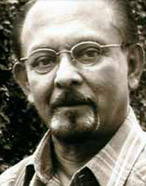 |
||
|---|---|---|
| CP Foundation | About CP Biennale | 2003 | 2005 | Contact Us | >||
           
|
||
|
Beginning with an effort to seek out a specific identity after returning home from the United States in 1970, Pirous felt compelled to delve more deeply into his own religious and ethnic identity as an individual born in the midst of the Islamic culture of Aceh. This search carried him to a determination to bring spiritual concepts into painting with the goal of creating works of art that have the capability to induce a spiritual interaction, while remaining highly accessible to the people of Indonesia, the majority of whom are Muslim. With this concept as a basis, Pirous started exploring the various aspects of Islam in Aceh. His rediscovery of the past and traditions, in particular Arabic calligraphy, played a major role in Pirous's career. To Pirous, Arabic calligraphy has communicative and expressive potential. Because he is not tied to closely to the traditional style of calligraphy, his works don't reflect any specific established style of calligraphy. He perceives the calligraphic letters he uses in his works as very dependent on the idea, materials, tools and techniques he is employing, and not dependent upon a specific style. For Pirous, the working process is a form of "ijtihad", or an effort to seek something new. The determination (Ikhwal) to create something new is important to Pirous because it is his view that as a creature of Allah, the most perfect of his creations, why should we only copy what He has done. Why shouldn't we see His creation as an endless source of inspiration and ideas? With the power to create, an artist has the potential to elaborate on those sources of inspiration to create something new. In his most recent works, Pirous has interpreted the theme "interpellation" set forth by the CP Open Biennale as an effort to rethink what kind of stance contemporary human beings take toward civilization. This humanistic questioning was induced by the recent military aggression against Iraq by the United States and its allies, which besides triggering a humanitarian crisis also symbolizes a gross lack of concern and respect for civilization and culture. The country of Iraq, and most Middle Eastern nations, have been noted throughout the history of mankind as the cradle of civilization. Seeing what was occurring in Iraq, the question arises: Is the vast legacy of civilization of the past even the least bit important to the world today? Pirous has begun exploring this question visually through the language of symbols. Ancient civilization is represented through the culture of its literature on 8 panels. Each panel symbolizes the literary tradition of a specific civilization, starting with the cuneiform writing that originates from Mesopotamia, ten moving on to the hieratic script and hieroglyphics of ancient Egypt, then to Hebrew writing, and Arabic calligraphy, the on to the literary tradition born with ancient Greek culture. Except for the Arabic writing, the text depicted on his canvasses is only symbolic. Here we can see Pirous consistency in relation to his treatment of writing: calligraphy of all kinds is a medium to convey a concept in a communicative manner that is simultaneously expressive. Irma Damayanti Born in Meulaboh, Aceh, Indonesia. SELECTED SOLO EXHIBITIONS SELECTED GROUP EXHIBITIONS |
||
|
CP Foundation | About CP Biennale | 2003 | 2005 | Contact Us
Jl. Suryopranoto 67A, Jakarta 10160, Indonesia. ph. +62.21.3448126, 3853206 | fax. +62.21.3853203, 3853208 info@cp-foundation.org |
||
 "Writing has two aspects: a communicative aspect and an expressive aspect... In my painting, these two aspects become one, they can't be separated... Both are born at the same time in my canvases and mutually support and strengthen one another as structure".
"Writing has two aspects: a communicative aspect and an expressive aspect... In my painting, these two aspects become one, they can't be separated... Both are born at the same time in my canvases and mutually support and strengthen one another as structure".